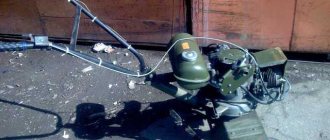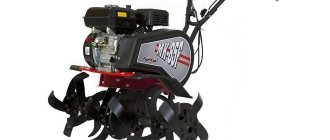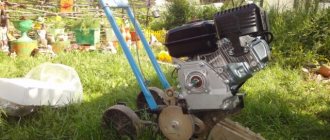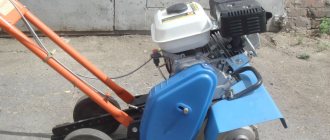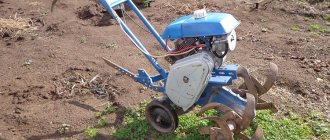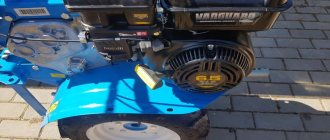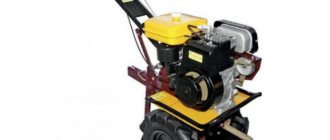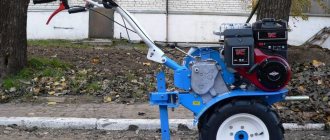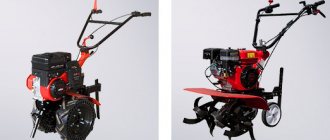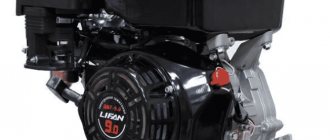"Benzolator" and universal assistant
The Mole motor-cultivator became one of the first domestic products of small-sized agricultural machinery, in general the first motor-block, the mass production of which was organized in our country. From 1983 to this day, Krot motor cultivators have been produced at a number of machine-building enterprises from Moscow to Omsk, and in the 2000s - also at Chinese plants and factories. During this time, how has the walk-behind tractor proven itself in the hard-working hands of summer residents, gardeners and farmers? What are the features of its design, advantages and disadvantages? How is “Mole-2” different from “Mole-1”? Read on.
Technical characteristics of the Mole walk-behind tractor
The Mole walk-behind tractor is equipped with a two-stroke engine, a carburetor and forced air cooling. The engine and gearbox are attached directly to the frame. The output shaft of the gearbox is connected to the motor using a V-belt drive. 2 tubular handles extend from it to control the device. With the help of the latter, the clutch, speed and reverse are controlled, if the model has such a function.
The Mole walk-behind cultivator is equipped with a two-stroke engine
The modification determines what characteristics the Mole walk-behind tractor has. All models have the following features in common:
- the average speed is 5-6 thousand per minute;
- the unit has a single-cylinder two-stroke engine, so it is fueled with a mixture of A-76 gasoline and oil in an approximate ratio of 25:1;
- the entire range of devices has transport wheels for moving walk-behind tractors when they are turned off;
- The coulter is included in the delivery set and is used to adjust the depth of tillage;
- The mechanism is started using a manual starter.
Mole walk-behind tractors, the technical characteristics of all models of which are similar, have the following basic parameters:
- dimensions: length – 100-130 cm, width – 35-81 cm, height – 71-106 cm;
- the fuel tank holds up to 3.6 liters of fuel;
- productivity – up to 200 sq. m. per hour;
- tillage width – 35-60 cm, depth – up to 25 cm;
- Engine power ranges from 2.6 to 6.5 liters. With.
All walk-behind tractor models have common features
Spare parts for mole walk-behind tractor and specifics of work
The motor cultivator comes with 4 cutters (the cultivator will move during soil cultivation due to them): two outer ones are attached to the left gearbox shaft, and two inner ones are attached to the right one.
The motor cultivator can also be used with six cutters, which will significantly increase its productivity. But it is not recommended to use a larger number of cutters to avoid damage caused by excessive loads on the engine and frame.
The depth of soil milling is adjusted by installing a coulter. During operation, the operator, by changing the load on the coulter, can adjust the depth of processing, as well as prevent the cultivator from burying in one place, because the engine has a Mole piston, the walls of which are tinned and therefore tightly ground into the cylinder.
Design features
The structure of the Mole walk-behind tractor is determined by the presence of the following interconnected nodes:
- Frame – consists of two connected half-frames. The structure is attached to the gearbox with bolts.
- Internal combustion engine - is attached to the frame and is connected to the input shaft of the gearbox via a V-belt drive.
- The attachment mounting bracket is located at the rear of the unit.
- Milling cutters - are put on the output shafts of the gearbox.
- Transport wheels.
- Fuel tank (located at the top of the device).
- Gearbox.
- Controls are located on the handles of the cultivator.
The motor on the Mole walk-behind tractor from the manufacturer has forced cooling and is a two-stroke single-cylinder engine. It contains a non-removable starter, which is started by sharply pulling the cable.
The engine uses a dry type air cleaner, and the carburetor is similar in design to a moped, as on the “Karpaty” or “Riga” mopeds.
The engine for the Mole walk-behind tractor has a working volume of 60 cm cubic and is filled with A-76 gasoline, to which is added Autol engine oil (M-8B1) in the proportion specified in the instructions for this model (1:20-1:25). The factory equipment includes “A-17B” spark plugs; for stable operation and to prevent the formation of carbon deposits, it is recommended to replace them with “A-11” spark plugs.
The motor on the Mole walk-behind tractor has forced cooling
Some models of the Mole walk-behind tractor are equipped with Chinese four-stroke engines. The “native” cultivator engine lacks power, which affects the performance of the mechanism. The design of the frame allows you to replace the engine with a more suitable one, which eliminates problems in the future.
The best options for such replacement are the following models:
- LIFAN 168FB with a shaft diameter of 20 mm and a power of 6.5 hp;
- Patriot;
- Honda GC 135;
- Sadko DE-220;
- Forza 160F.
When installing the engine, it is important not to exceed the permissible power. If you take an engine of more than 6.5 liters. With. the gearbox often begins to break due to excessive loads.
The size of the belt for the Mole walk-behind tractor is determined depending on the model. There are only three sizes suitable for models of this brand:
- A13*900 – devices with an imported four-stroke engine;
- A13*700 – suitable for the first modifications with the “original” engine;
- A13*750 – suitable for most models with a gearbox pulley diameter of 150 mm.
The value “A13” means the belt profile, and the numbers 900, 750, 700 are its length.
Some models of the Mole walk-behind tractor are equipped with Chinese four-stroke engines
Standard cutters for the Mole walk-behind tractor have a diameter of 330 mm. They are mounted on the power take-off shaft. The choice of cutter model depends on the type of soil being processed. So, for medium and light soils, 1-2 pairs are used, and for virgin soil you will need three.
Before cultivating the soil, it is necessary to raise the transport wheels and install the coulter on the trailing bracket. It is he who will regulate the depth of soil cultivation. If the soil being processed is dense and heavy, then it is better to use crow's feet cutters, and for soils with less hardness, cutters with four or three blades are suitable.
Attachments
Additional attachments increase the functionality of the walk-behind tractor, turning it into a universal agricultural implement. Mole walk-behind tractors can be combined with a large range of attachments.
Milling cutters
Used for cultivating soil to a given depth.
Saber knives "Crow's feet"
There are two types of cutters:
- Saber-shaped (active), assembled from steel knives. They are included in the package, but their number varies depending on the power of the walk-behind tractor - weaker models have 4 cutters, more productive ones have 6.
- “Crow's feet” have triangular tips that easily cut through even virgin soil without leaving any sticking.
Adapter
This is a special device consisting of a seat, a frame and additional wheels (one or two), which is installed on the walk-behind tractor using a hitch.
Adapter
Thanks to the adapter, the unit turns into a lightweight mini-tractor.
Trailer
The trailed trolley can have different dimensions and load capacity. The maximum weight it can carry is 500 kg.
Cart
The main purpose of the trailer is to transport piece and bulk cargo.
Mowers
In the summer, it is advisable to use a walk-behind tractor as a mower; for this you only need to purchase, or make your own, the appropriate attachments.
Segment mower Rotary mower Front mower
There are several types of mowers:
- segmental;
- rotary;
- frontal.
The most popular is the segment mower. It works on the principle of scissors.
Wheels
Pneumatic tires
They are present in all Mole models and are used for:
- transporting goods in conjunction with a trailer;
- to transmit forward motion when working with a mower and snow blower;
- to transport the walk-behind tractor itself to the place of work (then the wheels are removed and either cutters or lugs are installed in their place).
To improve the unit's traction with the ground, the wheels are equipped with powerful treads.
Crawler attachment
Tracked module
This hitch increases the area of contact with the ground, improves traction and maneuverability, especially in winter.
Lugs
These are large metal wheels with welded ribs, placed on the shaft instead of pneumatic wheels. The role of the lug is to transport the walk-behind tractor forward and fluff up the soil with its ribs.
Grounders
Plow
A reversible plow is used to plow the land. It has similar functions to cutters, but the plow is more relevant to use during the initial processing of virgin soil and in the fall, as an additional weed control.
Plow
In other cases, it is better to plow with cutters - they do not damage the fertile soil layer and cultivate it well.
snow blower
In winter, the Mole walk-behind tractor in combination with a snow removal attachment is suitable for clearing the area of snow.
Snow blower Brush Shovel blade
There are several types of snow removal attachments:
- auger snow thrower (throwing range up to 5 m, the operation involves an auger with blades and an impeller);
- brush;
- blade (a shovel with which you can work not only with snow, but also with other bulk materials).
Potato planter
Used to mechanize the process of planting potatoes.
Potato planter
Seed potatoes are poured into the bunker, a special device grabs them one by one and places them in a pre-made furrow to a certain depth. A soil ridge is then formed on top of the vegetable. The distance between the tubers is set in advance.
Potato digger
This equipment allows you to quickly and efficiently harvest potatoes. The vegetables are grabbed and pulled out, while the soil is sifted through special rods, leaving the potatoes intact.
Potato digger KRT-1
Weights
Weights are placed on the shaft and wheels of the walk-behind tractor and allow the unit to sink deeper into the soil. The use of weights is relevant on machines whose weight does not reach 100 kg.
Weights
Hitch
One of the most important components of a walk-behind tractor is the hitch. This device allows you to combine the walk-behind tractor with any attachment. There are two types of couplings: with regulation and without it.
Hitch
In adjustable models, you can set not only the horizontal, but also the angle of attack.
Model range: description and cost
The line of Mole walk-behind tractors is constantly expanding, and more and more advanced models are being produced. Production facilities are located in Omsk and in Moscow at the mechanical engineering enterprise named after V.V. Chernysheva.
Soil milling occurs without turning over the soil, which has a positive effect on its condition and the degree of oxygen saturation. These units are successfully used not only on plots of land, but also in greenhouses and greenhouses.
A feature of the entire line of cultivators and walk-behind tractors is the ability to replace the motor and install a new one from another manufacturer with better characteristics.
MK-1A
The model is equipped with a gasoline engine with a power of 2.6 hp. The small size of this unit and low weight (48 kg) allow it to be used in confined spaces. Maneuverability and the ability to cultivate to a depth of up to 25 cm are an important advantage. Reverse speed is not provided in this unit. However, this disadvantage is compensated by the possibility of using attachments and a working width of up to 60 cm.
Device parameters 130 cm*81 cm*106 cm.
Motoblock Mole MK-1A
KROT-2
A modification of the Mole 2 walk-behind tractor has a 3.6 hp Greenfield motor and a chain gearbox. The air filter has been improved, and the steering column has height adjustment. The weight of the unit is 68 kg, which allows the use of up to 6 cutters.
Models equipped with domestically produced engines have a shorter service life (about 400 engine hours), which causes low demand for such products.
The technical characteristics of this walk-behind tractor are as follows:
- productivity – 150-200 sq.m. at one o'clock;
- weight – 51.5 kg;
- tillage depth – up to 25 cm;
- cutter diameter – 320 mm;
- working width: minimum – 350 mm, maximum – 600 mm.
Motoblock Krot-2
MK-4-03
This motor cultivator has an American-made Briggs&Stratton motor with a chain gearbox and a power of 4 hp. Belt clutch and two speeds - forward and rear - allow you to cultivate the soil to a depth of up to 30 cm with a working width of up to 90 cm (minimum width 350 mm). The model copes well with attachments and is suitable for various agricultural work.
The weight of the product is 53 kg, the steering column has only one position. Cultivator parameters 1300x810x1060 mm.
MK-5-01
The technical characteristics of this modification are the same as the previous model. The main difference is the presence of a 4 hp Honda GC135 engine.
The walk-behind tractor has a chain gearbox and a belt clutch, as well as rear and forward speeds. The weight of the device is 53 kg, its steering column has only one position. The cultivation width ranges from 34 to 90 cm. The dimensions of the mechanism coincide with the MK-4-03 model.
Motoblock Mole MK-5-01
MK 9-01/02
This is a modern modification with a powerful motor (5.5 hp) made in Germany – Hammerman CF168F. This unit is capable of cultivating virgin lands and is not difficult to install attachments.
Weight and other parameters are the same as the previous model.
Owner reviews
What do our experts—ordinary owners of summer cottages and vegetable gardens who were lucky enough to buy a “Mole” motor-cultivator—say about this agricultural technology? Let's take a look at a few reviews:
Ivan Andreevich, 54 years old
“In general, I really like the MK-1A-02 “Mole” motor-cultivator! I have been using this machine for 17 years, the unit has proven itself to be a reliable piece of equipment. During the entire period of operation, there were several serious breakdowns: the magneto was covered - I had to replace it, at first the engine stalled, but I quickly figured out what was wrong - I thoroughly cleaned the carburetor and henceforth did not go to work with the walk-behind tractor uncleaned from dust and dirt. A couple of times during the process of plowing the field I had to tighten the mounting bolts, the machine immediately stopped rattling like a rattle. Well, what else - I changed the seals a couple of times. The functionality is impressive, I had to buy some equipment, some I made myself (snow blower). Guys, I recommend it to everyone - you won’t regret it!”
Vasily, 39 years old
“My father had the first Mole cultivator. So when buying, I already knew in advance what I was buying. I am satisfied with everything: a very affordable price and good performance. I read reviews that say the walk-behind tractor is not suitable for virgin soil - it’s too weak, I’ll answer - if you go through several stages, and in different directions, virgin soil will obey! My wife and I bought a house with a large plot, the land was like that - we thought nothing would work out! But the motorized cultivator pleasantly surprised us; we slowly and quietly took on this virgin soil. The main thing here is to know how and not to retreat!”
User manual
In the operating instructions supplied with the Mole walk-behind tractor, the manufacturer indicates the following information:
- setting up mechanisms and troubleshooting;
- safety rules when working with the unit;
- features of using the device;
- information about the parameters and structure of the agricultural machine.
Reliable and long-term operation of the walk-behind tractor depends on proper and regular maintenance, as well as on competent and constant care. The user needs to perform simple manipulations to care for the mechanism. In this case, the cultivator can last more than 10 years.
As fuel, you must use a mixture of AI-80 or AI-76 gasoline and M-12-TPTU or M8V1 oil.
The operation of the walk-behind tractor depends on proper and regular maintenance.
The oil level must be constantly monitored and, if necessary, replenished to the required amount. After each use of the cultivator, it is important to clean it from dirt. At the end of the procedures, the agricultural machine is wiped dry and its working units are lubricated.
First start
Correct startup of the walk-behind tractor when first used determines its future service. This process is called break-in and lasts at least 15 hours. Before and after break-in, it is important to check whether the level of working fluids corresponds to the norm and top up, if necessary, to the required amount.
The running-in process consists of going through the following stages:
- Checking the units, components and motor for functionality. Check the gearbox thoroughly.
- Determining the oil level in the crankcase. Running the engine dry will cause it to seize.
- It is not recommended to load the walk-behind tractor during the running-in period. The best option is idling. In extreme cases, the load on the device should not exceed 50% of normal.
If all the requirements are met and the first launch was successful, then we can confidently say that the parts of the mechanism have gotten used to each other well. This is an important condition for the further successful operation of the cultivator.
The oil level in the walk-behind tractor must be constantly monitored.
Service
Maintenance of the walk-behind tractor involves regularly performing the following operations:
- adjusting;
- washing;
- fastening;
- control;
- lubricants;
- gas stations and other works.
The frequency of such manipulations ranges from 5 hours to 1 time per season. Let's consider the classification of periodic work by frequency of execution.
Every 5 hours the following manipulations are carried out:
- cleaning the area around the muffler, the entire cultivator, wiping it dry;
- cleaning the outer surfaces of the cylinder head and the cylinder itself;
- replacing oil in the motor gearbox (after the first 5 hours of operation);
- inspection of fastening connections of the chassis and engine;
- monitoring the oil level in the chassis and gearbox;
- monitoring the tightness of chassis and engine gearboxes, carburetor, gas tank and fuel line.
It is not recommended to load the walk-behind tractor during break-in.
Every 25 hours or once a season:
- V-belt transmission adjustment;
- cleaning the air filter and monitoring its condition;
- checking the fastenings of threaded connections of the chassis and engine using spare parts tools;
- Changing the oil in the chassis gearbox.
Every 50 hours or every season:
- cleaning spark plugs;
- replacing the filter element in the air filter; this procedure can be carried out more often when working in difficult conditions;
- Changing the oil in the engine gearbox (at elevated ambient temperatures, this is done more often - after 25 hours).
Every 100 hours or every season:
- lubrication of control cables;
- installing a new spark plug;
- cleaning and lubricating the starter;
- muffler cleaning;
- changing the oil in the chassis gearbox;
- cleaning the grooves of the piston rings, piston, cylinder head, and exhaust purge windows of the cylinder from carbon deposits.
Follow the instructions to prevent premature malfunctions.
Every 300 hours or every season:
- flushing the gas tap and carburetor;
- flushing the fuel tank.
Basic malfunctions and ways to eliminate them
To prevent premature malfunctions, you should follow the instructions specified in the operating instructions for the motor cultivator. Since all Mole models do not contain plastic parts, this increases their service life.
The most common breakdowns of this walk-behind tractor include:
- clogging the space between the knives and the gearbox housing with clods of earth;
- the handle and frame structure sometimes need reinforcement;
- malfunction of the rope starter and piston group;
- long periods of downtime (more than one season) render the cylinder, magneto, piston and other parts unusable.
How to start without a starter
If the starter breaks down, the user faces the problem of starting the device. Therefore, it is important to know how to start the Mole walk-behind tractor when the starter is not working.
Most often, a walk-behind tractor has a starter failure
. The procedure is as follows:
- Remove the starting device.
- Find a cable or clothesline 1.5 to 2 m long.
- Run the end of the cord into the hole to which the starter was mounted.
- Wrap the cable around it, leaving 50 cm free.
- Attach a small holder to the end of the rope.
- Pull the cord sharply and firmly.
- Repeat the previous action until the mechanism starts.
The method described above is dangerous, so it should only be used if absolutely necessary. It is recommended to purchase a new starter and replace the old one with it. If you do launch using a rope, it is important not to wrap it around your hand. Otherwise, a limb may become pinched by the engine and, as a result, serious injury may occur.
Does not start
If the Mole walk-behind tractor does not start, you need to check the following parameters:
- fuel flow into the carburetor;
- control lever position;
- inspect the spark plug;
- make sure there is fuel in the tank.
It is necessary to check the flow of fuel into the carburetor if the walk-behind tractor does not start.
It is important to determine why the Mole walk-behind tractor does not start; the reasons for this may lie in electrical ignition faults.
To make sure of this, you should:
- Unscrew the spark plug. If it is dry, this is a sign that gasoline is not getting to the carburetor. It is necessary to dry the cylinder and bleed the engine when the spark plug is wet. If there is carbon deposits, it is necessary to clean it with sandpaper soaked in gasoline.
- Check the ignition by turning the crankshaft. Normally, a bright blue candle should be visible.
- Replace the spark plug with a new one if the problems persist.
- Check that the gap between the coil and the ignition wire is correctly set.
- Make sure the fuel hose is in good condition.
- Check to see if the magneto and flywheel wires are tight.
Unidentified violations during self-check are a reason to contact a service center for professional repair of the unit.
No spark
The reason for the lack of spark is a faulty spark plug, namely:
- carbon deposits - clean the candle;
- a spark appears, but the engine does not start - oil or fuel has got onto the tip of the spark plug;
- fuel fills the cylinder from time to time, which leads to the spark plug becoming wet and causing no spark;
- spark plug failure;
- A faulty O-ring is a possible cause of the malfunction.
Electric ignition malfunctions may also be the reason why the Mole walk-behind tractor does not start
Wedge
During operation, the engine may seize. This happens for the following reasons:
- the formation of scoring on the connecting rod head due to a tight fit of the piston pin, improper installation of the part, or lack of lubrication;
- insufficient oil supply;
- connecting rod failure.
If you suspect jamming, you should disassemble the motor and ensure the integrity of the components and parts. Damaged or deformed elements must be replaced. Otherwise, the motor will quickly break down and become unmaintainable.
What to do if the cultivator does not start
The reason for this may be the presence of old oil, and the symptoms may be the presence of white exhaust. In this case, the oil urgently needs to be replaced with a new one. Also, the cultivator may not start due to lack of oil in the fuel tank. Therefore, before using this unit, you need to check the amount of liquid in the tank. You also need to remember that each engine runs on a specific brand of fuel, and in order to refuel a two-stroke engine, you need to prepare a separate liquid (mix oil and gasoline in the proportions given in the technical descriptions and diagrams). It is also advisable to buy high-quality fuel at trusted gas stations.
DIY cultivator repair
Self-repair of a Mole walk-behind tractor that is under warranty is not rational. Under such circumstances, it is better to contact a service center. If the warranty period has passed, you can try to fix the problem yourself.
The Mole walk-behind tractor is a simple device, so a simple breakdown in it can be fixed by anyone familiar with the operating instructions and the block diagram.
The most common breakdowns are:
- air filter contamination;
- lack of spark;
- incorrect gap between the electrodes (norm 0.8 mm);
- ignition problems.
Self-repair of the Mole walk-behind tractor is not rational
Usually, owners of these walk-behind tractors encounter problems with the operation of the motor. It may not start at all or work intermittently.
Signs of malfunctions are:
- audible interruptions in operation;
- during startup and operation, the power does not increase to the required level;
- the engine stops spontaneously.
The algorithm for checking for problems is as follows:
- Determine if there is fuel in the gas tank.
- Inspect the fuel filter (if you suspect a lack of fuel entering the carburetor). Clean the filter if necessary.
- Start the cold engine.
- Make sure that the carburetor choke is in the closed position.
Seek professional help if you are unable to independently identify problems and fix them.
Owners of these walk-behind tractors usually encounter problems with engine operation.
How to set the ignition
To set the ignition, use a special probe and set the gap between the electrodes within 0.6-0.8 mm. After this, check whether a spark is formed from the contactless magneto MB-1.
It is recommended to use spark plugs A-11 or A17B.
Belt replacement
You should purchase a belt for the Mole walk-behind tractor in accordance with the manufacturer’s instructions in the instructions. Installing unsuitable models from unknown manufacturers will result in additional problems.
To replace the belt, proceed as follows:
- Switch to neutral gear and turn off the engine.
- Remove the protective cover and old belts.
- Even if one of the belts is not worn enough, both should be replaced. You can use scissors for removal.
- Remove the pulley from the drive shaft and put new belts on the gearbox shaft pulley.
- Take the removed pulley and pull the belts onto it, then install it on the motor shaft. In this case, the key must be installed correctly, otherwise the pulley will not rotate.
- Make sure that the belts are not distorted and place them on top of the tension rollers.
- Attach the protective cover in place.
Tracked module
Installing a tracked module will allow the cultivator to navigate off-road, loose snow and other difficult surfaces. The device provides good cross-country ability on all types of surfaces, increases stability and eliminates the possibility of equipment slipping.
Track tracks are usually made of polymer materials. This approach makes it possible to reduce the weight of the structure, which will reduce the load on the drive mechanism.
Nowadays it is quite difficult to find a tracked module adapted for installation on the KROT cultivator. We recommend looking for universal mechanisms that are produced for MB type walk-behind tractors. Some models are compatible with the products of JSC MMP im. V.V. Chernyshev".
Lugs
They are made of high-quality metal with a special coating that protects the structure from corrosion and external influences. Grousers are used to improve traction with the supporting surface and increase the weight of the cultivator, which simplifies movement on loose soil.
The main parameters of lugs are diameter and width. Due to the simplicity of the design, many cultivator owners prefer to make this type of attachment themselves.
snow blower
Snow blowers are designed to clear snow from paths, sidewalks, garden plots, parking areas and other places where the use of large equipment is difficult or impractical.
The principle of operation of the mechanism is based on the rotation of the shaft, which captures the snow mass and moves it to the center with subsequent release through a special bell. The range depends on the engine speed.
Potato planter
Simplifies the process of planting root crops. The simplest models are designed for planting potatoes in one row with a given step. Productivity depends on the type of model and the capacity of the planting material hopper.
High-quality models perform a full working cycle in one pass - the device cuts a furrow, pours potatoes into the holes, covers them with soil and forms even rows. In this case, the depth of processing, planting frequency, row spacing, as well as the height and shape of the ridge can be set in advance.
Potato digger
Helps in harvesting. The simplest fan design is a ploughshare with welded curved metal rods. The use of such devices allows for the presence of weeds during the work process.
The operating principle of the potato digger is as follows:
- The ploughshare loosens the ground with its sharp edge;
- The root crop is removed from the ground and falls on the inclined part of the ploughshare, moving towards the rods;
- The soil separates from the potatoes and falls to the ground through the rods;
- Clean root crops fall onto the arable land.
Many plot owners make their own equipment for harvesting potatoes.
Weights
The purpose of this attachment is to increase the total weight of the cultivator. This makes it easier to navigate difficult surfaces due to better traction.
A classic weighting agent is a cylindrical metal container that is filled with bulk materials.
